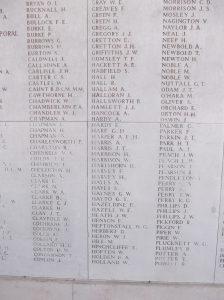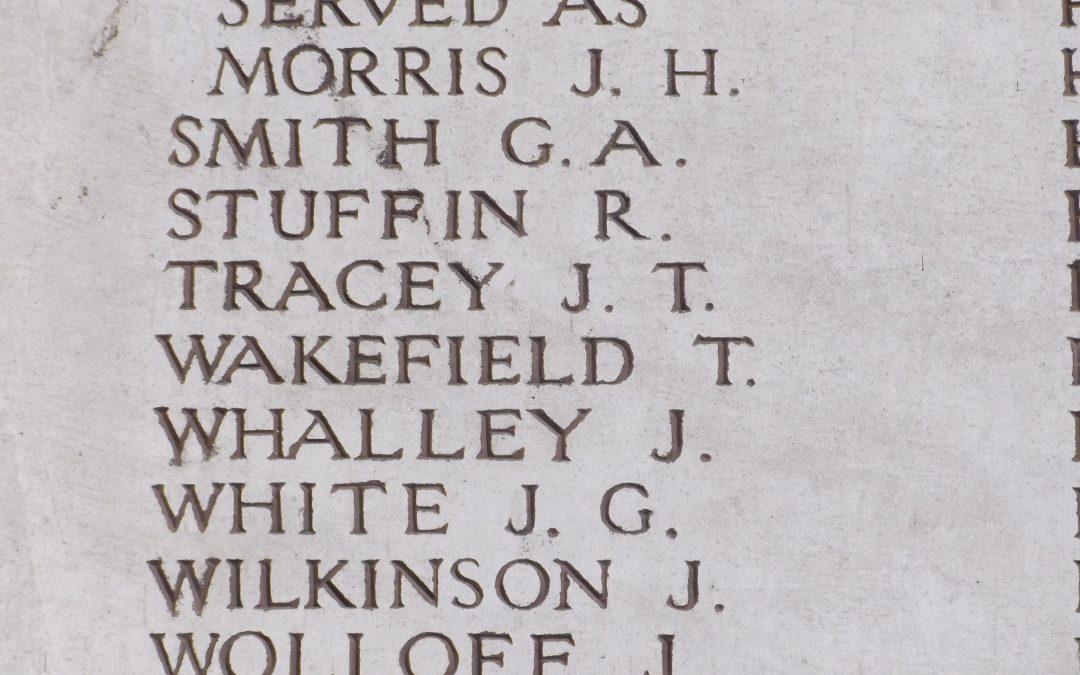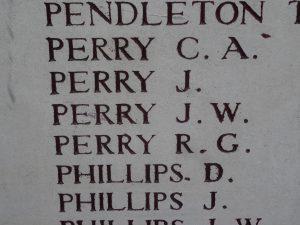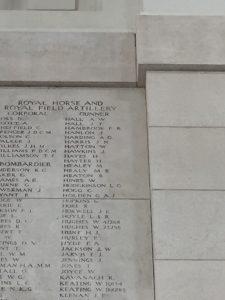
by James | Jul 31, 2017 | Remembrance
Today we were privileged to be visiting the Menin Gate to remember George Henry Hare of Dunsby who was killed exactly 100 years ago on this date, 31st July 1917, on the first day of the Battle of Passchendaele. George being the author’s Gt Gt Uncle.
George was born in Dunsby, Lincolnshire, in the summer of 1895, to John Hare, a farm Horseman born in Wigtoft and his wife Sarah Sharpe born in Pinchbeck. John and Sarah were married in 1882 and had 12 children, unfortunately loosing 3 of their children before 1911.
Their married life started in Pinchbeck, quickly moving to Quadring and eventually settling in Dunsby in 1884 where their remaining children were born.
Mary Jane Hare, 1882, Pinchbeck
Elizabeth Hare, 1883, Quadring
William Sharp Hare, 1884, Dunsby
John Hare, 1887, Dunsby
Charles Hare, 1888, Dunsby
Walter Hare, 1890, Dunsby
Alice Hare, 1892, Dunsby
George Henry Hare, 1895, Dunsby
Ethel May Hare, 1896, Dunsby
George found work as a farm labourer and was living at home in Dunsby fen aged 16 in 1911.
George enlisted into the army in Bourne and was posted to the 15th Battalion Sherwood Foresters (Notts and Derby Regiment). This was a bantam Battalion made up of men under 5 feet 3 inches typically from mining or agricultural backgrounds. Although they were ordered to Egypt in late 1915, this was cancelled and their first overseas posting was in February 1916 to France where the Battalion fought in the Battle Somme
George was posted to the 16th Battalion Sherwood Foresters, although it is not known exactly when this occurred. Typically a wounded soldier would upon regaining fitness, after a period of time, be posted to a Battalion where they were most in need of replacements.
We can be sure that George was with the 16th Battalion in his final month as their diary mentions a new draft on the 15th June but none since.
The 16th had move from the Ancre area of France in November 1916 into the Ypres Salient. Here they remained until the end of June 1917 when they were moved from the Hilltop Sector near the Ypres-Yser Canal, to Northern France. Once in Serques the Battalion underwent training in preparation for the big attack planned for the Ypres Salient.
On the 21st / 22nd of July George along with his 16th Battalion, were moved by Motor Lorries and Motor Busses close to Poperinge and then marched to a rest camp near Wornhoudt. They remained bivouaced here until the 27th July.
The next day they were moved back to their old stomping ground of the Hill Top Sector relieving the 6th Lincolnshires.
The following is an extract from the Battalion Diary describing their movements in the lead up and on the first day of the Battle of Passchendaele.
30th July – Hill Top Sector
The Battalion Assembled in our own front line trenches to assault the German Trenches and capture their front line system. A Company on the right front and B Company on the left front wire detailed to capture and consolidate the German front (red) and support (yellow) lines. Whilst C Company on the left passed through and went forward to capture and consolidate the German reserve line (Blue and Dotted Blue lines). The 11th battalion, the Royal Sussex Regiment were on our right and 17th Battalion King’s Royal Rifle Corps on our left.
31st July – Hill Top Sector
At 3.50am the artillery barrage opened and our four lines advanced to get as close under it as possible. The men followed closely and the objectives assigned to the Battalion were secured with little difficulty by A Company commanded by Captain C G Lord, B Company commanded by Captain P H Coleridge, C Company Commanded by Captain L H Askwith and D Company by Lieutenant T C O Williams.
The enemy held these trenches lightly and only put up a weak resistance. During the advance the Battalion captured 120 prisoners and 2 machine guns. Advanced Battalion Headquarters were established in Camphor Trench (Reserve Line) and the consolidation of the Dotted Blue Line commenced.
At 8.30am A Company was withdrawn for work under the 227th Field Company Royal Engineers for road construction.
During the day the greater part of the Battalion was employed in carrying forward the Brigade dump and carrying forward SAA bombs, wire and water to the 17th Battalion Sherwood Foresters and 16th Battalion Rifle Brigade who had captured Kitchener’s Wood and the trench system up to the River Steenbeek.
At 4.30pm C Company was sent up to reinforce the 17th Battalion Sherwood Foresters and came under command of the Officer Commanding that battalion. One Platoon of this Company was sent forward to the line of the River Steenbeck.
About 9pm B Company was similarly sent up to reinforce this line 2nd Lieutenant A S Mellor was wounded whilst conducting a camping party to Kitchener’s Wood.
At some point between Assembling in Hornby and Forward Trench at Zero minus 3 and the end of the first day of the Battle of Passchendaele (3rd Battle of Ypres), Private George Henry Hare was killed in action.
Commonwealth War Graves Commission:
In Memory of Private George Henry Hare, 33949, 16th Battalion, Sherwood Foresters (Notts and Derby Regiment) who died on 31 July 1917 Age 21.
Remembered with Honour Ypres (Menin Gate) Memorial
Panel Ref: Panel 39 and 41
George is also commemorated on the war memorial in his native Parish Church in Dunsby, Lincolnshire.
“their name liveth for evermore”




by James | Jul 31, 2017 | Remembrance
Our second act of remembrance for today is for a Rippingale man who also appears on the Dowsby Memorial.
In memory of Private Arthur Palmer Hill, 11898, 8th Battalion, Lincolnshire Regiment who died on 31st July 1917.
Remembered with honour, Ypres (Menin Gate) Memorial, Rippingale Memorial and Dowsby Memorial.
RIP Arthur



by James | Jul 31, 2017 | Remembrance
Today we have three commemorations.
For our first we remember Lance Corporal Thomas Wakefield, 15486, 1st Battalion Coldstream Guards who was killed in action 100 years ago on 31st July 1917 in the Western European Theatre in France and Flanders, serving with his Battalion the first day of the battle of Passchendaele.
Born and brought up in Haconby by his publican parents.
Commonwealth War Graves Commission:
In Memory of Lance Corporal Thomas Wakefield, 15486, 1st Battalion Coldstream Guards who died on 31 July 1917.
Remembered with Honour Ypres (Menin Gate) Memorial and Hacconby Memorial
Panel Ref: Panel 11



by James | Jul 30, 2017 | Remembrance
Today we commemorate the 100th anniversary of the death of John William (Jack) Perry of Bourne and the 17th battalion, Sherwood Foresters.
Jack was born in Bourne late in 1898 to William Thomas Perry, an Insurance Agent born in Hilgay Northamptonshire and his wife Edith Amy Creasey born in Swineshead.
They were married in 1896 in the Boston area and had two children, Violet Amy born in Bourne in 1897 and Jack.
On census night 1901 Jack and his sister Violet are living with their maternal grandparents in Bicker, his mother having died earlier this year and his father boarding in Peterborough.
By 1911 Jack and Violet are living with their uncle, Christopher Creasey in Bicker.
At some point Jack was adopted by his mother’s widowed sister Harriet Bannister nee Creasey.
On the 11th November 1915 Jack enlisted into the 3/4th Battalion of the Lincolnshire Regiment and following training eventually posted to France in June 1916.
Whilst serving with his Battalion in October, Jack was gassed and hospitalised. Following his return to fitness he was posted to the 17th Service Battalion of the Sherwood Foresters (Welbeck Rangers) and served with “D” Company.
By June 1917 Jack’s new Battalion were serving in the Ypres Salient in the area around the Ypres-Yser Canal Bank and Irish Farm working every nightime hour possible. On the 1st of July moved to Moulle in Northern France via Poperinge.
They stayed in the Tilques area undertaking training in advance of planned operations until the 22nd of July when they were bussed back to the Ypres area.
On the 29th July they were moved up to the Canal Bank area and on the 30th “Y” day they were resting prior to the attack. At 10:30pm the Battalion moved up to the place of assembly in the Hill Top Trenches.
Assembly was complete by 1:15am on “Z” day 31st July and the Battalion Diary reports that no casualties occurred whilst the Battalion was in assembly.
Zero Hour was at 3:50am on the 31st when the 3rd Battle of Ypres (Battle of Passchendaele) started. The 6th Army Corps in which the 39th Division and hence the 17th Sherwood Foresters were posted were to attack on a one and a half to two mile front.
The Battalion Diary offers the following report of actions on the 31st July;
“Yesterday we carried all before us, it was one of the Battalion’s greatest days lines etc, formation. we penetrated the enemy defences, which he had held for over 2 years, to a depth of 2 miles. It was a glorious feat and worthy of the Sherwood Foresters’ record. The day is very bad and the ground full of water and mud. We have secured the crossings of the Steenbeek and have dug in, the enemy is expected to counter attack. The Battalion is quite prepared to resist to the end.
In total the men and officers of the Battalion were recommended for the following gallantry awards for actions on the 31st July 1917, the first day of the battle of Passchendaele.
26 x Military Medals
1 x Military Medal Bar
1 x Distinguished Service Order
9 x Military Cross
1 x Distinquished Conduct Medals
The Battalion held firm against counter attacks, shelling etc until they were relieved on the 5th August.
Private John William “Jack” Perry was killed in action during the first day of the battle of Passchendaele.
All official records state that he fell on the 30th July however one newspaper record states that it was the 31st, which if you take the information from the battalion diaries makes more sense.
Commonwealth War Graves Commission:
In memory of Private John William Perry, 70021, 17th Battalion, Sherwood Foresters (Notts and Derby Regiment) who died on 30 July 1917 Age 18. Adopted son of Mrs H. J. Bannister of 3 Victoria Place, Bourne, lincs. Remembered with honour, Ypres (Menin Gate) Memorial.
Rest in Peace



by James | Jul 28, 2017 | Remembrance
Today we commemorate the 100th Anniversary of the death of Billingborough man Leslie Grosvenor Hodgkinson, killed in action 28th July 1917.
Leslie was born in early 1894 in Billingborough the eldest of three sons born to Charles Grosvenor Hodgkinson, a Journalist born in Grantham and his wife Mary Ann Burrows of Swinsted.
His two brothers Charles Norman, 1895 and Thomas Basil, 1897 were also born in Billingborough. Their parents had married in the Nottingham area in 1893.
The young family made their home on the High Street in Billingborough as can be seen in the 1901 census although by 1911 Leslie was working as an insurance clerk and living at 14 Mansfield Grove, Nottingham and lodging with Fanny Nelson.
The young men of Billingborough were quick to answer their call and the Grantham Journal carried an article on the 12th September 1914 naming the “Local Patriots”
“Several Billingborough and Horbling young men have rallied most patriotically to the nation’s call. Their names and the regiments in which they have enlisted are as follows:-H.J. Tebb, Royal Horse Artillery, R,W Tebb, Royal Horse Artillery and Herbert Tebb, 11th Hussars, sons of Mr. H. Tebb (Horbling); Leslie G Hodgkinson, Royal Field Artillery and C Norman Hodgkingson, Royal Engineers, sons of Mr. C.G. Hodgkinson; Ernest Smith, Royal Field Artillery and Albert Smith, Oxford and Bucks Light Infantry, sons of Mr. William Smith, Bootmaker. Mr Smith has also another son in the regular service, viz., Bandman Archie Smith, 3rd King’s Royal Rifles. The following have enlisted in Lord Kitchener’s New Army: – Fred Harrison, son of Mr. H.C. Harrison; Walter Nicholson, W. Carpenter (Horbling), Frank Corn, W. Watson (Horbling), Harris Ellingworth (Horbling), W. Swin (Horbling), H. Kemp (G.N. railway clerk, Billingborough), W. Birch and W.H. and J.F. Pattinson (Stow). Mr. John Marshall, hairdresser, who saw active service in the South African war, has also been accepted. The Yeomanry ranks include Eric Barber, son of All. J.S. Barber, of Rookfield. There are several others serving in the Regular Army. The recruits mentioned are in addition to the lads – mostly farm hands – who enlisted on Monday night.”
A further article on the 24th of December 1914 mentioned Leslie Hodgkinson as one of the lads that had recently been home for short leave.
Leslie was posted to “B” Battery of the 58th Brigade Royal Field Artillery and sailed with them and on the 9th August they landed at Anzac Cove in Galipoli. A week later it was moved to the Left Flank Artillery in the Suvla Bay area and came under temporary command of the 10th (Irish) Division.
Leslie wrote a letter home that was edited into an article by the Grantham Journal on the 21st August under the headline “Sunshine and Flies”
Writing from “Somewhere with the British Mediterranean Expeditionary Force” Bombardier Leslie G Hodgkinson, of the R.F.A. gives some interesting particulars of the difficulties encountered by the troops. He says their greatest troubles are the intense heat and the pestering habit of the flies. There is one continuous blaze of sunshine from the rising to the setting of the orb, and the hottest days in England are not in it with the heat out there. there are myriads of flies, covering their food every time it is served, and pestering them at all times, more especially when they want to snatch a few hours’ sleep. The sand blows about in blinding clouds, covering everything and they must have eaten quite a lot with their food. Although we, in England, have been having record rains this summer, they have not seen a spot since they left England at the beginning of July. In spite of the discomforts, the general health of the troops is good, and a fine spirit of courage and determination pervades the lot of them.
The Brigade remained in Galipoli until the 18th December 1915 and sailed for Alexandria, Egypt, arriving there on the 2nd January 1916. They stayed in Egypt for 6 months, a regular story for many of the ex Galipoli brigades, before being posted to France in preparation for the Somme offensive.
Leslie is next mentioned in another Grantham Journal article on the 23rd June 1917.
“ON LEAVE- Mr. C. G. Hodgkinson’s eldest son, Leslie who is in the R.F.A. has returned home this week for his first leave, after being abroad for two years. After going through the Gallipoli campaign, he was sent to Egypt for six months, prior to being transferred to France, where he has been fighting since June 1916. His battery was engaged in all the big battles on the Somme and although he saw severe fighting at Arras, La Boisselle, Pozieres, Thiepval, Courcellette, Le Says, Bapaume and Bullecourt, his worst experiences were in the Ypres Sector. With his Artillery officer, he went over the top with the infantry and tells some thrilling accounts of what he saw after the explosion of the mines. In spite of the long and arduous work he had had to perform and the privations and hardships suffered on the Gallipoli Peninsula , he looks very little the worse for his experiences.”
Leslie rejoined his battery in the Ypres Salient immediately after his leave, although his return was short lived as less than a month later he would be killed in action just days before the battle of Passchendaele (3rd Battle of Ypres) commenced.
In memory of Gunner Leslie Grosvenor Hodgkinson (20981)
“B” Bty, 58th Bde, Royal Field Artillery who died on 28 July 1917 Age 23
Son of Charles Grosvenor Hodgkinson and Mary A Hodgkinson, of Billingborough, Lincs
Remembered with honour, Ypres (Menin Gate) Memorial.
We were very honoured to be in Ypres on the 100th anniversary of Leslie’s death and were pleased that we could pay our respects on this sad anniversary.


















Recent Comments